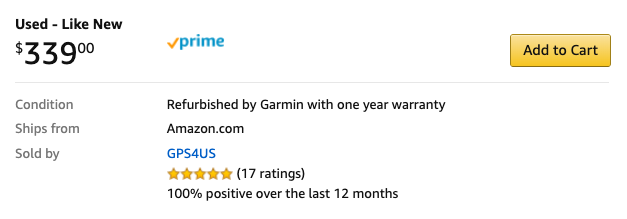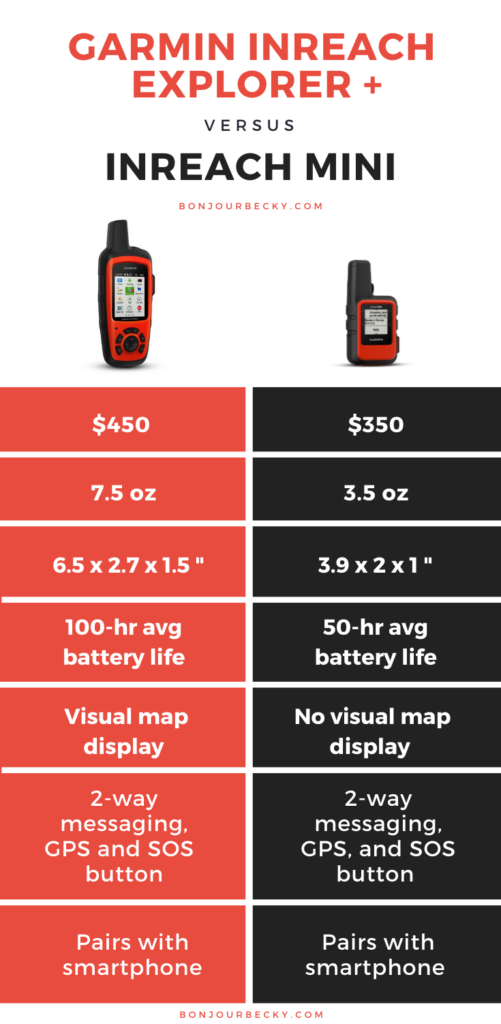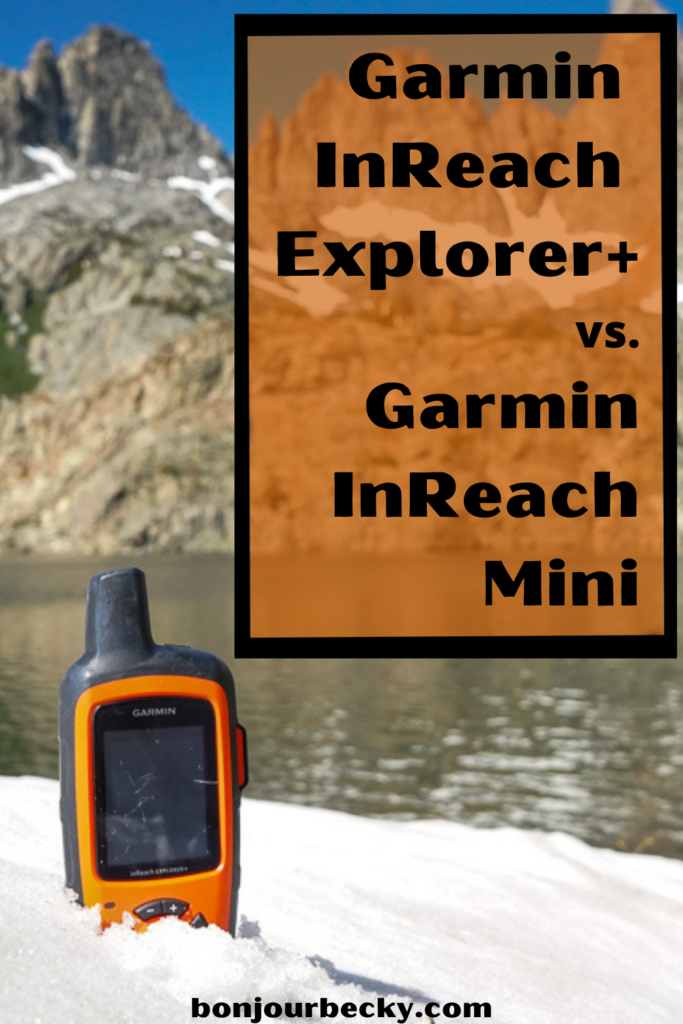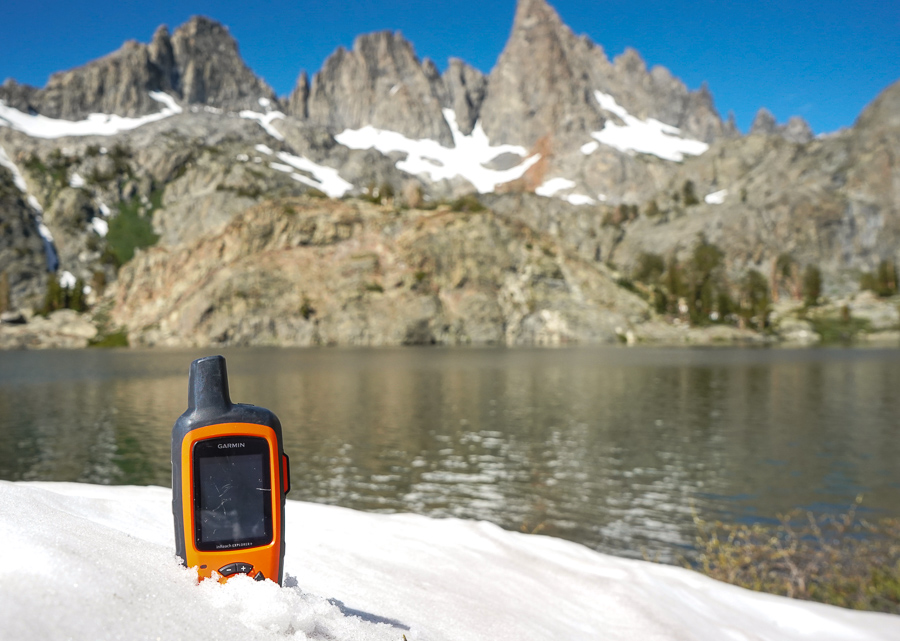The #1 Piece of Gear Most Likely to Save Your Life (Or Just Your Butt) |
When people ask what gear I recommend for hiking, my #1 answer isn’t a fancy sleeping bag, a lightweight tent, or a special pair of boots. It’s a pointy orange Clif bar-sized device called a Garmin InReach.
The Garmin InReach is a magical piece of gear. It lets you text from the trail, share your exact location, and call for help in an emergency — all without cell phone service.
The InReach is the reason I feel confident adventuring alone, and the reason my loved ones don’t freak out when I do.
Here’s why I love my Garmin InReach and what you should consider before buying one.
How It Works
The InReach is a 2-way messenger and GPS device that uses a vast network of iridium satellites to communicate with the world.
Because it uses satellites and not cell phone towers, it can send a message from literally anywhere on earth with a clear view of the sky.
It connects to your smartphone via Bluetooth, allowing you to type custom messages using your smartphone keyboard instead of the clunky menu on the device itself. Those messages are then sent by satellite.
Who is the Garmin InReach for?
Wilderness travelers
If you spend time in places without reliable cell phone service, whether that’s deep in the wilderness or on lonely desert highways, you could use an InReach.
Say you’re hiking with a friend who falls and breaks their leg badly. Rather than leave them behind to go find help, which is more dangerous for both of you, you can use the InReach to text back and forth with medical personnel and get advice until help arrives.
And if you’re hiking alone? The InReach could literally save your life.
Sometimes when I watch adventure movies or read headlines about lost hikers, I wonder how the situation could have been different if they’d carried an InReach. 127 Hours would have been closer to 127 Minutes, and James Franco might still have his arm. The woman who went for a “quick run” in Hawaii and emerged gaunt but alive 2 weeks later wouldn’t have made headlines. (NB: The InReach needs to see the sky to work, so there’s a chance it wouldn’t have worked inside a narrow canyon/deep jungle, respectively. But it’s worth thinking about.)
Solo road travelers
In my own life, I first bought an InReach after getting my car stuck in the mud on a dirt road on Carrizo Plain. I was many miles from the nearest pavement, with zero cell service and not another soul in sight.
If I’d had in InReach, I could have texted my parents or then-boyfriend my coordinates and had them send someone to help me. But I had no way of communicating with anyone.
After a panicked, lonely couple of hours I eventually chased down a drone. This led me to a man who didn’t speak English, who helped me flag down a man who did, who helped me flag down another man with a truck and a tow strap, and I was rescued… but if I hadn’t been lucky, I would have been stuck there lord knows how long.
Even though that story had a happy ending, the fear I felt being stuck (literally) in the middle of nowhere with no way to call for help stuck with me. I bought an InReach the very next day.
People with worried friends and family members
Even if you’re not worried about someday needing help—which you should be, because accidents can happen to literally anyone— there’s probably someone out there who does worry about you. A lot.
For me, it’s my parents. They’re supportive of my travels, but they also love me and fear for my safety when I travel alone. Unfortunately, as a solo female, I’m more at risk than a man would be.
When I’m sleeping in my Subaru at rest stops or dispersed campsites without cell service, I use the InReach to text my parents to let them know I’m safe. When I’m backpacking, they can see my route and know I haven’t been eaten by a bear or attacked by a psycho. I text them every night from camp with my coordinates so they know I’m happy. (And if they don’t hear from me the next morning, they know exactly where to start looking.)
The InReach has made my family more supportive of my adventures, especially as a solo female traveler. And they love getting texts from the trail!
Is the Garmin InReach really worth it?
Short answer: if you go places without cell service, yes.
If you’re just getting into hiking and staying on well-known, established trails, there’s no need to rush out and buy one just yet. If you mainly hike in local parks with cell phone service, a phone will work just fine. Same goes for very popular trails in areas without service, like Angel’s Landing in Zion National Park. If you were injured there, you’d likely have people swarming to help faster than you could reach your InReach.
But if you’re traveling in places with spotty cell coverage and few people, ask yourself this: what is my life worth? If your answer is more than $350, then the InReach is worth it.
That might sound dramatic, but a quick scan of Garmin’s more than 2,000 real-life rescues will show you how real it really is. They’ve helped save people with broken bones, severe altitude sickness, heart problems, hypothermia, and more — all of which could have been deadly without a fast response.
How to get the best deals on the Garmin InReach
As great as the InReach is, it still ain’t cheap. Here’s how to save a few bucks on yours.
Look for Refurbished Models
Amazon sells many used InReach models that are Certified Refurbished by Garmin. These can be as much as $100 off sticker price and are guaranteed to work as good as new. (When buying used, make sure it’s certified by Garmin with their standard 1-year warranty.)

Wait for REI’s Anniversary or Holiday Sales
Electronics are typically excluded from REI sale discounts and coupons, like the 20% coupons sent to members several times a year.
However, REI will often temporarily discount the InReach during the following annual sales: their Anniversary Sale (typically mid-May) and their Winter Sale (typically mid-November.) During the last Winter Sale, for example, which coincided with their #OptOutside campaign, the Garmin InReach Explorer+ and InReach Mini were both $30 off retail. This is the best discount you can typically expect. (Amazon will price-match for the duration of the sale, but please support REI if you can.)
If you do buy the InReach at full price, it will count towards your REI member dividend, which means you’ll get a percentage of the purchase (usually ~10%) back within a year.
Pay over 6 months (interest-free) with an Amazon Store Card
If you have an Amazon Store Card, you’ll have the option to pay for large purchases over the course of 6 months without paying any interest. For the InReach Explorer +, that would be ~$73/month for 6 months instead of $440 up front.
Share an InReach with a friend
You share your Netflix subscription — why not an InReach subscription, too? Splitting the costs with a close friend or significant other can give you both peace of mind.
If you go on a trip together you’ll only need one device, and if one of you goes on a solo adventure you can send that person with the InReach. (The only problem is when you go on separate trips.)
I borrowed my dad’s InReach before I bought my own, and have let friends borrow mine multiple times when they’re going on a trip and I’m staying home that weekend. Each of those friends loved it so much they eventually bought their own.
Choose the right subscription plan
Yes, the InReach requires a subscription plan to activate it on top of the pricey product itself. There are many options, from unlimited custom messages to limited, pre-set ones and annual subscriptions vs. month to month.
Stay tuned for my guide to choosing the right InReach subscription plan, and don’t pay for one you don’t need. The basic $15/month plan is perfect for most travelers. (SOS function is always included.)
InReach Explorer+ vs. the InReach Mini
In 2017 Garmin introduced the InReach Mini, a smaller, cheaper alternative of the InReach Explorer+. The InReach Mini has the same messaging capabilities and GPS as the Explorer+, but without the visual maps function.
After using my dad’s InReach Mini on a week-long backpacking trip in Utah, I like both. Here’s a quick comparison:

Overall, the Mini is a great option for someone who just wants the 2-way messaging function but plans to navigate via their phone and/or a paper map. (Always bring a paper map as backup — and know how to use it!)
InReach FAQ
Which subscription plan should I get?
It depends! (I’m actually working on a guide to this: stay tuned!) If you’re off the grid at least once a month for more than 4 months out of the year, an annual subscription is the better deal. You’ll also be able to take off on a trip at any point without wondering, “will this thing still work?”
If you only go on a handful of big trips per year, though, paying by the month only when you plan to use your InReach will save you some cash.
Do I need additional rescue insurance?
Short answer: probably not.
In the U.S., search and rescue services are typically free, staffed by volunteers and supported by a mix of local government funds and private donations. (That’s why you should donate to your local SAR, or better yet, volunteer — especially if you’ve ever needed rescue services yourself.)
International travel is a different game, and you should look into additional trip insurance for the country you’ll be visiting.
That said, you should never assume that rescue is available, or put yourself in risky situations assuming help will come. Wilderness rescue is dangerous for first responders and, even when it works perfectly, it’s rarely fast. Don’t put yourself and your rescuers at risk.
What about other satellite devices?
The Garmin InReach isn’t the only satellite messenger on the market: it’s just the only 2-way messenger/GPS combo.
Another popular satellite device is the Spot messenger, which works similarly to the InReach but doesn’t let you send custom texts. With the Spot, you check-in with 3 different status updates instead: OK, Not OK (but don’t send help yet,) and SOS (send help). There’s also an automatic tracking function like on the InReach.
The Spot is cheaper than the InReach and helpful to have on the trail, especially compared to just a cell phone. Many hikers swear by it, but in my personal experience the Spot tracking can be a bit, um, Spotty. And often, you need to communicate more nuance than “OK” or “Not OK.” If you’re springing for a satellite device, I’d invest in the InReach.
Do you use a Garmin InReach or other satellite messenger? Have questions about buying or using one? Let me know in the comments!




4 Comments
Leave your reply.